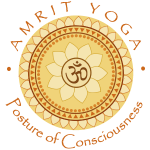What is it about Amrit Yoga that sets it apart from other Yoga teaching traditions? Most forms of Yoga being taught today are primarily focused on perfecting various yoga postures, improving physical health and fighting off the effects of aging. A quick Google image search on the word yoga backs this up by showing row after row of young, svelte, toned bodies holding a variety of cool yoga postures.
Amrit Yoga also focuses on postures. If you missed yesterday’s post or Sunday’s, both are very much about postures. The majority of class time is spent in postures; so, how is that different from any other tradition of Yoga? Amrit Yoga teaches that postures are just a tool, an entry point to the real work of Yoga: Inward exploration. Patañjali’s definition of Yoga is this: Yoga is the stilling of the modifications of the mind. “What’s so great about stillness?” you might ask. Stilling the mind is what allows us to experience peace. It is this stilling that is the work of Amrit Yoga’s inward exploration.
Like any journey, there is a definite map for this inward journey and some very specific tools you’ll use along the way. Today we’ll just take a look at the map, where it starts and where it leads us.
Stage I: Willful Practice
Like any journey, this one starts right where you are now and then moves you into Stage I: Willful Practice. Willful practice starts with some of the most commonly practiced Hatha Yoga postures but, as I wrote earlier, these are only the entry point to the journey. Postures are practiced deliberately and with as much precision as possible which sounds suspiciously like trying to perfect the pose but the intent of this precision is very specific: Connect mind to the sensations of the body and begin to train the mind to be very steady and disciplined. As the mind becomes steady and well connected to the body, we become more and more sensitive to the subtle energy of the body, prana. With continued practice we discover that this energy, prana, follows attention. This leads us to the next point on the map.
Stage II: Will and Surrender or The Conscious Crossover
With the mind steady, connected to bodily sensation and aware of prana, the scenery of our journey begins to change. Instead of using postures to find prana—energy following our attention—we begin to follow prana to find the postures—attention follows energy. In this practice we willfully, consciously create stillness or raise prana and then surrender into that stillness or into the movement of prana as it is released. Where a Stage I practice is very deliberate and precise, a Stage II practice is more of a dynamic flow between willfully performed techniques and postures arising spontaneously from the movement of prana. As we are better able to let go into the movements and postures of prana, we move into Stage III.
Stage III: Surrender
Stage I and II both require willful action either as a guiding force in Stage I or as a supporting force in Stage II. In Stage III the practice is simply to allow prana to move and allow the body to respond to that movement. The practitioner moves fully from being the doer of the actions into the passive observer of the actions. The practitioner no longer chooses what to do or what to avoid. The postures the body performs may be recognizable, traditional postures or they may be completely foreign. Stage III practices cannot be taught as there is nothing to teach, only the experience of prana moving the body. It is very likely that this Stage sounds very alien and even impossible; however, most of us experience this sense of surrender on a daily basis in the form of morning stretches or sleepy yawns. No one plans a morning stretch, it just appears. No one plans a yawn, there is suddenly a need to yawn and it happens. This is prana at work moving the body.
What is the Point?
Why start this practice? Why move from Stage I to II to III? What is the end destination of our journey? I wrote at the beginning of this little journey that Patañjali defined Yoga as “stilling the modifications of the mind.” At all points along our journey from Stage I to Stage III, stillness will rise and descend. Is the stillness found in Stage I less than the stillness found in Stage III? No, stillness is not better or worse. Stillness is or is not. All three Stages teach us to access stillness in different but related ways. Gurudev often says that “Everything I teach takes you to the same place.”
If a Stage I practice takes me to the same place as a Stage III practice, why bother? Stage I has moments of stillness and the length of those moments increase through Stage II and Stage III takes place in a single moment of stillness. Life also presents us with an ever changing face, taking this journey from Stage I to Stage III helps us move through life with stillness no matter what face is before us.
Each Tuesday for the next three weeks, we’ll take a closer look at each of the Stages, what tools are available to us and some common experiences in each Stage.
Until next time, Jai Bhagwan!


